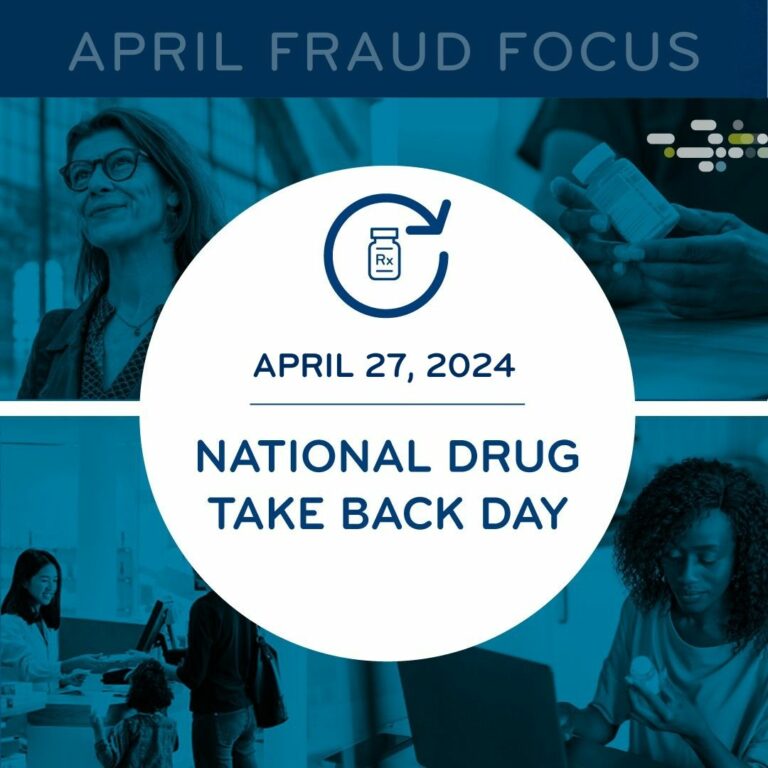Perspectives
April Fraud Focus – How to prioritize drug safety at home
April 23, 2024 While ensuring drug safety is often considered the responsibility of pharmaceutical industry players, such as the U.S. Food and Drug Administration (FDA), drug manufacturers, pharmacies and pharmacy benefit managers (PBMs), it’s something you can, and should, prioritize at home.
While ensuring drug safety is often considered the responsibility of pharmaceutical industry players, such as the U.S. Food and Drug Administration (FDA), drug manufacturers, pharmacies and pharmacy benefit managers (PBMs), it’s something you can, and should, prioritize at home.
National Drug Take Back Day
According to the National Institutes of Health, about half of people who misuse prescription pain medication get them from a friend or relative. And almost 50% of people in the U.S. have used at least one prescription drug in the past 30 days, according to the Centers for Disease Control and Prevention (CDC).
One easy way to prevent drug misuse is to properly dispose of any unused or expired medications through the U.S. Drug Enforcement Administration (DEA)’s biannual National Drug Take Back Day at select locations from 10 a.m. to 2 p.m. on Saturday, April 27.
While there are year-round locations to drop off various types of prescription and over-the-counter medicines — including aerosols, capsules, creams, gels, inhalers, liquids, patches, pills and powders — National Drug Take Back Day brings together key industry players to encourage families to take the time to clean out their medicine cabinets and prevent drug misuse, poisoning or accidental overdose.
So no, you shouldn’t toss your meds in the garbage, which ends up in landfills, or down the toilet, which can be dangerous to water supplies and may cause plumbing issues down the road.
Dropping off medications at one of the 4,600 participating pharmacies, hospitals and businesses around the country (or 17,000 registered pharmacies that accept collections any time of year) is easy, convenient and anonymous — there’s no fee and no need for ID. Simply package up your medicines in the original containers (or, if you’ve tossed the original packaging, place your medications in quart-sized plastic bags), and drop the drugs into the designated, usually self-serve drop boxes. Make sure to check the instructions for your local drop-off locations, as well as confirm what medications they accept, since it can vary by location. Learn more about how and where to safely dispose of unused medications at the FDA’s website.
In October 2023 alone, 300 tons of unused drugs were collected as part of National Drug Take Back Day. And since the program started nationwide in 2010, more than 8,950 tons were collected.
But now is not only a good time to dispose of medications, it’s also a good time to evaluate the storage of your current medications. Keep them out of reach of children and pets, and make sure you follow the directions on the label carefully. Don’t be scared to ask your doctor or pharmacist questions! The CDC also recommends securing prescription narcotics, such as morphine, opioids or codeine, in a locked cabinet or drawer.
FDA’s Drug Safety and Availability website
There are other ways to prioritize drug safety at home, all year round. The FDA offers information for consumers and health professionals regarding drug label changes, shortages of medically necessary drugs, new drug warnings and other safety information through their Drug Safety and Availability web page. You can download a mobile application (via the Apple App Store and Google Play Store), as well as subscribe to their newsletter for updates on recalls and shortages.
The FDA’s Center for Drug Evaluation and Research (CDER) also produces FDA Drug Safety Podcasts, which provide emerging safety information that aligns with their Drug Safety Communications.
Other resources include their medication guides, which provide additional information on prescription drugs, such as side effects, drug interactions, proper storage instructions and ingredients, as well as FAQs about drugs, and the FDA review and approval history.
DEA drug database and drug scheduling
The DEA also offers educational resources through their drug database and materials related to drug scheduling and penalties. There’s also information about Naloxone, which can be used to reverse an opioid overdose.
Local resources
There also are local safety resources at your disposal (no pun intended), including your local pharmacist and primary care physician. Medications can have various side effects and may interact with other medications, so be sure to speak with your primary care provider to make the safest decisions for you and your family.
Stay tuned for more fraud tips next week and watch for more information on X @Prime_PBM.
Related news
Perspectives
July 25, 2024
Quarterly Drug Pipeline: July 2024
Clinical insights and competitive intelligence on anticipated drugs in development
Perspectives
July 22, 2024
Oncology Insights: 2024 ASCO Annual Meeting key findings
Findings from this year’s American Society of Clinical Oncology (ASCO) Annual Meeting will likely lead to clinical practice changes and U.S. Food and Drug Administration (FDA) drug approvals or expansions
Perspectives
July 16, 2024
LISTEN NOW: Beyond the business – Stories of corporate kindness | Pharmacy Friends Podcast
In this episode, we talk about how our employees' help goes beyond our work in health care, aiding in philanthropic efforts